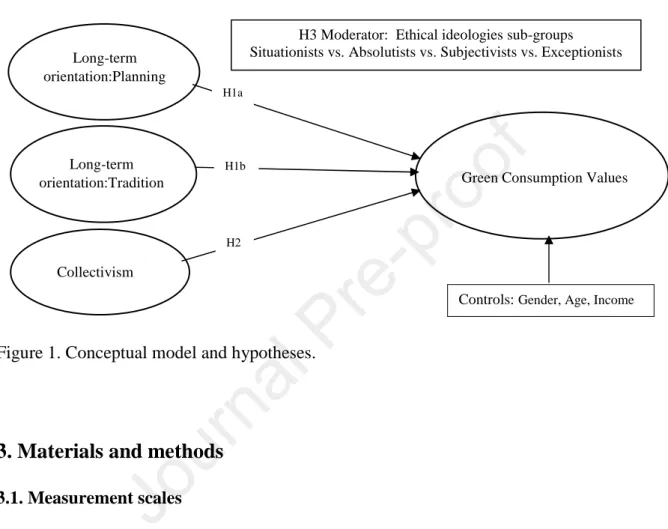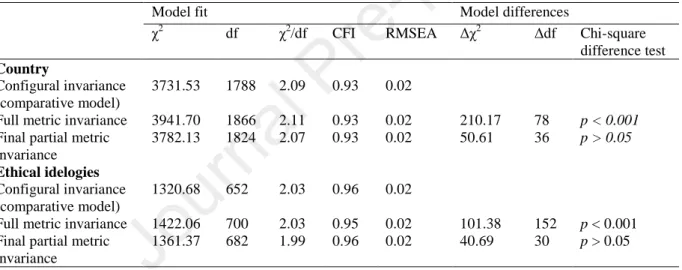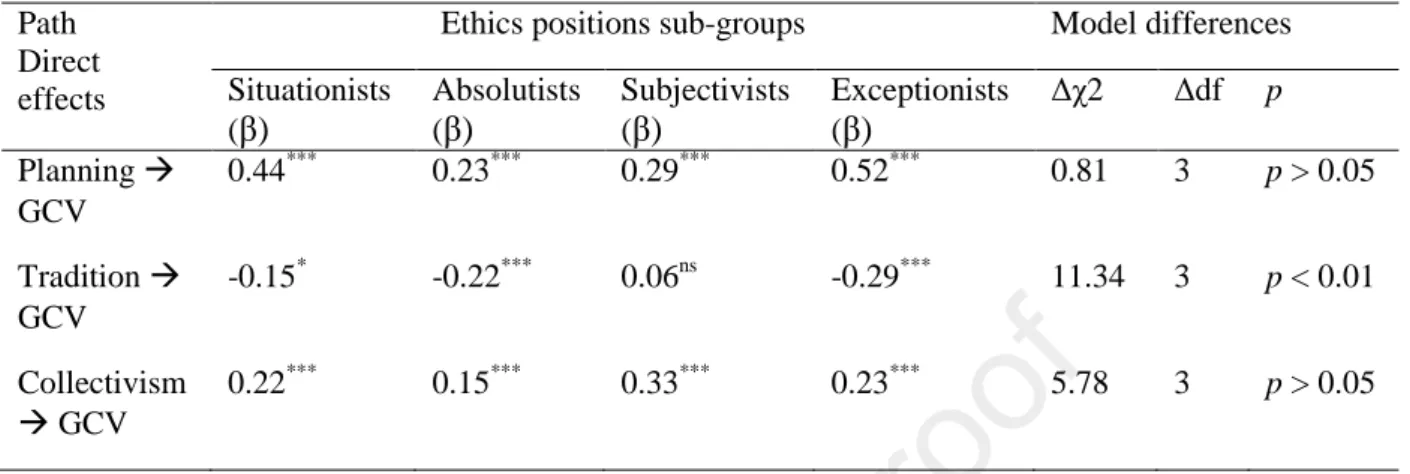Consequently, the inclusion of ethical ideologies in the analysis of green consumption values and behaviors would provide consistency to the findings (Luchs et al. Recent studies argue that an individual's green consumption values positively predict this consumption (Haws et al. 2014 , Bailey et al. 2016).However, current research is limited in analyzing the factors that contribute to the development of green consumption values among consumers (Bailey et al. 2016).
Culture plays an important role in influencing the green consumption behavior of individuals (e.g. de Maya et al. in their study Hassan et al. 2011) found the two subdimensions of long-term orientation valid in a study involving 10 European countries.
Controlling for socio-demographic influence
More recently, Ko et al. 2019) investigated the moderating role of ethical ideologies on the effect of ethical leadership on purchasing agents' unethical behavior. Therefore, we base our hypothesis on more general theoretical analysis of how the effects of cultural dimensions on green consumption values differ across the four ethical ideologies subgroups at the model level (Figure 1). H3 The relationships between cultural values and green consumption values differ across the four ethical ideologies subgroups.
Materials and methods
Measurement scales
In addition, some studies have also reported that consumers' income has significant effect on their pro-environmental attitudes and behavior (Scott and Willits 1994; Clark et al. 2003; Welsch and Kühling 2009). Therefore, we use a modified version of the EPQ proposed by Cui et al. 2005) consisting of a total of 12 items, six items per scale. We measure all items on a five-point Likert scale (1 = 'strongly disagree' to 5 = 'strongly agree') and present them in the appendix.
Data collection
Measurement validity
- Confirmatory factor model and discriminant validity
- Multi-group invariance analysis
- Common method bias assessment
A test of metric invariance, as a second step, determines the cross-group validity of the model beyond the underlying factor structure (Hair at al. 2010). First, we tested the metric invariance of the measurement model across countries and the result was not satisfactory, as the fully constrained model was significantly poorer than the fit of the configural invariance model (Δχ2 Δdf p <0.001). Therefore, the equality constraints on these parameters were relaxed and, consequently, the resulting model supported partial metric invariance (Table 3), as the model was not significantly worse than the fit of the configural invariance model (Δχ2 Δdf =50.61.
Similarly, with respect to the four ethical ideologies subgroups, we first did not achieve metric invariance, as the fully constrained model was significantly worse than the fit of the configural invariance model (Δχ2 Δdf p < 0.001). After relaxing the equality constraints of one item each in the planning and tradition scales, two items each in the collectivism and green consumption value scales, the resulting model supported partial metric invariance (Table 3), as the model was not significantly worse than the fit of the configural invariance model (Δχ2Δdf p > 0.05). Results of multigroup invariance tests regarding countries and ethical ideologies. χ2 df χ2/df CFI RMSEA Δχ2 Δdf Chi-square.
In Harman's one-factor test, we examined an exploratory factor solution unseeded with a single-factor solution, and it explained about 22 percent of the variance in the data set. Due to the limitations of Harman's single factor test, we used the “blue attitude” developed by Miller and Chiodo (2008) as a marker. However, the fourth item 'I hope my next car is blue' was removed from the analysis to improve the reliability of the marker variable (α followed a similar approach in their study although they suggested that "the theoretical irrelevance of the blue attitude it cannot be universally assumed".
Lindell and Whitney (2001) suggest that common method bias will be a problem if the correlation between any of the latent variables and the marker is greater than 0.3 (r > 0.3).

Empirical results
Structural model testing
This indicates that common method bias should not be a problem since the maximum variance explained by a single factor did not exceed the 50 percent threshold. However, this method suffers from several limitations as it does not statistically control for method effects and is more of a diagnostic technique to assess the extent to which common method variance may be a major problem (Podsakoff et al. 2003). This marker consists of four items “I prefer blue to other colors”, “I like the color blue”, “I like blue clothes” and “I hope my next car will be blue”.
We included all four items in the questionnaire and measured them on the same 5-point Likert scale as the other constructs in the model. Second, we conducted a confirmatory factor analysis with the marker variable following Gaskin and Lim (2017), and the resulting chi-square test for the null-constrained model appeared to be insignificant (Δχ2 Δdf p > 0.05). These analyzes indicate that common method bias should not be a problem in our study.
However, the results indicate that the effect of tradition on green consumption values is negative (β = -0.14, p < 0.05). Our results support H2, as the effect of collectivism on green consumption values is positive and significant (β = 0.25, p < 0.001). Among our control variables, the effects of age (β = 0.23, p . < 0.001) and gender (β = 0.13, p < 0.001) on green consumption values were significant and positive, indicating that older consumers and women have greater green consumption values than their colleagues.
Multi-group moderation analysis
Discussion and implications
Theoretical implications
It indicates that consumers who believe in collectivistic value would show greater green consumption values than consumers who believe in individualistic value. Furthermore, it appears that the positive effects of planning and collectivism on green consumption values would be greatest among the exceptionists and the subjectivists, respectively. However, the effect of tradition on green consumption values is only positive among the subjectivists, but insignificant and negative among all other subgroups.
The significant negative effect of tradition on green consumption values can be attributed to consumers' psychological barrier to adopting new types of consumption behavior that are environmentally friendly. Therefore, our study provides a new perspective on how consumers' long-term orientation affects their green consumption values in a cross-cultural context. Our results further indicate that the relationships between cultural dimensions and green consumption values differ across the four ethical ideologies proposed by Forsyth (1980).
We find that this variation is mainly due to the relationship between tradition and green consumption values. The effect of tradition on green consumption values is most negative among the exceptionalists (low idealism; low relativism). Planning also has the greatest effect on green consumption values among the exceptionists, in contrast to the effect of tradition on green consumption values among the exceptions.
Furthermore, the effects of both planning and collectivism on green consumption values appear to be positive and significant across the four ethical ideologies subgroups.
Managerial implications
This result is consistent with the characteristics of the exceptionalists who tend to balance the positive consequences of an action against the negative consequences of that action due to their low idealistic values, relatively orthodox beliefs and preferences for uncertainty avoidance (Forsyth 1980). This may indicate that the consumers who pay a lot of attention to planning for the future will have strong pro-environmental values even though they may have low idealistic and low relativistic ethical ideologies. Similarly, collectivism has the greatest effect on green consumption values among the subjectivists (low idealism; high relativism) suggesting that in a collective society consumers who make decisions based on personal values and perspectives rather than universal ethical principles will favor green consumption values to accept. .
This may suggest that consumers who pay close attention to planning for the future and believe in collectivist values will adopt pro-environmental consumption values regardless of their level of idealistic or relativistic ethical ideologies. As previous research has not adequately explored the complex moderating role of ethical ideologies subgroups on the relationships between culture and green consumption values, our findings contribute to the understanding of these relationships from a cross-cultural perspective. 2019) suggest that ethical leadership is most effective among individuals who are situational (high idealism; high relativism). Our study reveals that both planning and collectivism have similar effects on green consumption values among all four ethical ideologies subgroups.
Therefore, marketers should focus on forward-looking and collectivist consumers to promote environmentally friendly consumption by making it synonymous with ethical consumption. In other words, marketers should take a more audience-centric approach when designing culturally relevant marketing strategies for green products and services. Third, the study notes that women and older people seem to exhibit higher values of vegetable consumption than their male and younger counterparts, respectively.
Therefore, marketers should consider selective marketing strategies for green products that target the female and older consumers, especially the over 50s by meeting their expectations about social and environmental attributes of green products.
Limitations and areas for future research
The authors would like to express their gratitude to the survey respondents and to all those who provided support during the early stages of the study. The existence of potential harm to others is always wrong, regardless of the benefits. Investigating the role of religiosity, materialism and long-term orientation on consumer ethics in Indonesia.
A cross-cultural comparison of ethical attitudes of business managers: India, Korea, and the United States. Seeing the world through GREEN-tinted glasses: Green consumption values and responses to environmentally friendly products. The effect of ethical leadership on buyers' unethical behavior in China: The moderating role of ethical ideology.
In the eye of the beholder: Top managers' long-term orientation, operating context, and decision-making processes. The role of moral intensity and personal moral philosophies in the ethical decision making of marketers: A cross-cultural comparison of China and the United States. An empirical investigation into the relationships between a consumer's personal values, ethical ideology and ethical beliefs.
Sustainable food consumption among young adults in Belgium: Theory of planned behavior and the role of trust and values. The role of moral intensity and moral philosophy in ethical decision-making: a cross-cultural comparison of China and the European Union Business ethics: A European review. Effects of planning and collectivism on green consumption values are greatest among both the exceptionalists and the subjectivists.


